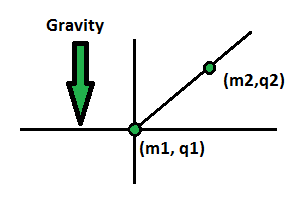Static Charged Particles on a Wire

In the -plane, there is a semi-infinite wire in the shape of the curve .
Particle 1, with mass and charge
, is fixed at the origin.
Particle 2, with mass and charge
, can slide freely along the wire.
There is a uniform downward gravitational acceleration
.
The Coulomb constant is
.
If Particle 2 is in static equilibrium, what is the -coordinate of its position (in meters, to 2 decimal places)?
The answer is 2.52.
This section requires Javascript.
You are seeing this because something didn't load right. We suggest you, (a) try
refreshing the page, (b) enabling javascript if it is disabled on your browser and,
finally, (c)
loading the
non-javascript version of this page
. We're sorry about the hassle.
Equate the force due to gravity and the electrostatic force of repulsion along the line y=x
Let the position of particle is (x,x)
kq1q2/2x^2 = 10*sin(45)
from here x = 3/2^(0.25)